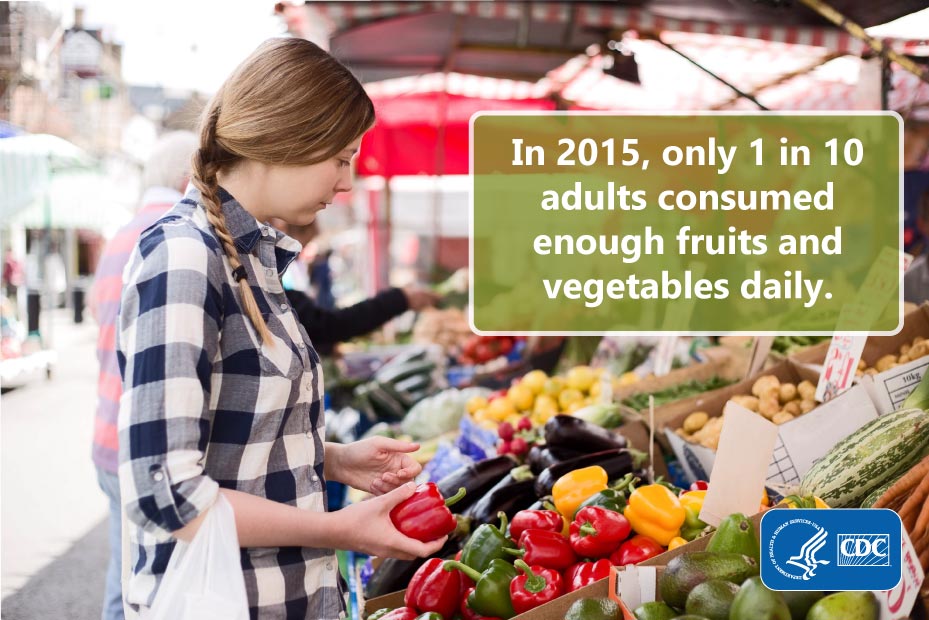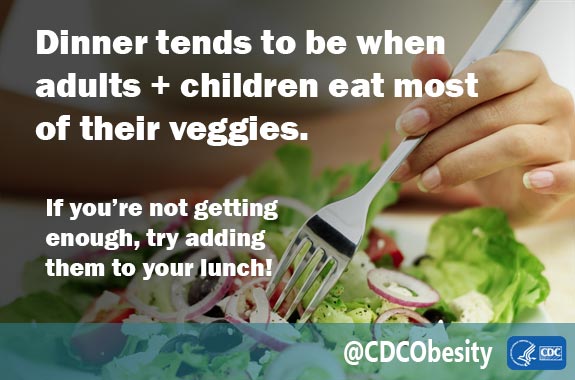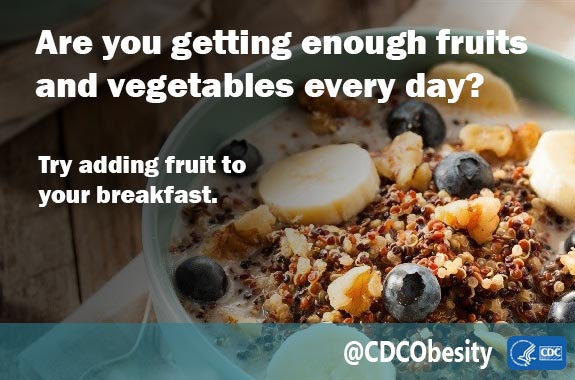Only 1 in 10 Adults Get Enough Fruits or Vegetables
Men, younger adults, and people with lower incomes get the fewest
This Page Is No Longer Being Updated
See more current data about fruit and vegetable intake among US adults.
Eating a diet rich in fruits and vegetables can help reduce the risk of many leading causes of illness and death, such as cardiovascular disease, type 2 diabetes, some cancers, and obesity. Despite these positive health benefits, few adults meet the recommendations.
Only 9% of adults ate the recommended amount of vegetables and 12% of adults ate the recommended amount of fruit, according to a CDC analysis of data from the 2015 Behavioral Risk Factor Surveillance System. Results showed that consumption was lower among men, young adults, and adults with lower incomes.
The study also found variations by state. For example, adults meeting fruit or vegetable recommendations ranged from 6% in West Virginia to 16% in Washington DC.
Overall there were no significant differences between different race/ethnicity groups for meeting the vegetable recommendations. However, in 10 states, a significantly higher percentage of people who were Hispanic and non-Hispanic Black met recommendations for fruit intake than did people who were non-Hispanic White.
| Adults Meeting Recommendations, 2015 | |
|---|---|
| Fruits | 12.2% |
| Vegetables | 9.3% |
Continued efforts are needed to identify and address barriers to fruit and vegetable consumption. Previous studies have found that high cost, limited availability and access, and perceived lack of cooking/preparation time can be barriers to fruit and vegetable consumption.
The CDC Guide to Strategies to Increase the Consumption of Fruits and Vegetables pdf icon[PDF-2.06MB] suggests 10 strategies to increase access to fruits and vegetables, including these:
- Start or expand farm-to-institution programs in childcare, schools, hospitals, workplaces, and other institutions.
- Improve access to retail stores and markets that sell high quality fruits and vegetables.
- Ensure access to fruits and vegetables in cafeterias and other food service venues in worksites, hospitals, and universities.
Time and money don’t have to be barriers to eating well. Visit MyPlateexternal icon from the US Department of Agriculture to learn how to make every bite count.
How much is enough?
The federal fruit and vegetable recommendations vary by age and sex:
Adult women need at least 1½ cups of fruit and 2½ cups of vegetables each day
Adult men need at least 2 cups of fruit and 3½ cups of vegetables each day.
Learn more: MyPlate Planexternal icon
Learn more! Read the Science and Brief pdf icon[290 KB, 2 Pages, 508] or listen to the podcast [03:58 minutes] associated with this MMWR.
Add more color to your plate!
- Save time and money by chopping extra fruit or vegetables at one time and freezing the extra.
- Choose frozen or canned fruits and vegetables at the store.
- Most adults get their fruit at breakfast. Add more fruit to your diet by grabbing a small apple or banana as your afternoon snack.
- Dinner time is when most adults eat their vegetables. Get more veggies in your diet by adding them to your lunch time sandwich, or packing carrot sticks or grape tomatoes as a snack.
- Learn how to put your best fork forward and add more fruit and vegetables to your diet.
- For more tips on convenient and affordable ways to eat a healthy diet, please visit MyPlate Planexternal icon.
- Are you getting enough fruit and veggies? 2015 data from @CDC_DNPAO and @CDCMMWR shows just 1 in 10 adults get enough.external icon
- What can be done to make sure adults eat enough fruits and veggies? Check out @CDC_DNPAO strategies.external icon
- #NewData from #MMWR: US adults still not eating enough fruits and veggies. Men, young adults, + people in poverty get less than peers.external icon
- Press Release: Only 1 in 10 Adults Get Enough Fruits or Vegetables
- Strategies that contribute to Healthy Food Environments
- Progress on Children Eating More Fruit, Not Vegetables, 2014
- Vital Signs Fact Sheet pdf icon[PDF-3.22MB]




